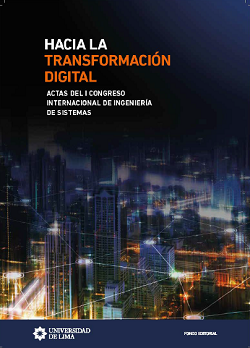Un ciclo de vida para crear un software no complicado
DOI:
https://doi.org/10.26439/ciis2018.5485Palabras clave:
desarrollo de software, modelo ciclo de vida, cascada, ágil, RUP, software de código legibleResumen
Los modelos de ciclo de desarrollo de software moderno tienden a ser menos formales y menos rígidos que los modelos basados en cascada del pasado. Sin embargo, crear software sin seguir un plan básico frecuentemente trae como resultado software de pobre estructura, con fallas y difícil de mantener. En este documento se plantea un método práctico con el propósito de desarrollar software. Seguir cierto orden en el plan producirá mejor código que no seguir ningún plan. Este modelo ha mostrado ser exitoso incluso con los desarrolladores inexpertos.
Descargas
Referencias
Alliance, S. (2015, July). The 2015 state of scrum, scrum-alliance-state-of-scrum-2015.pdf. Retrieved from https://www.scrumalliance.org
Banker, R. D., Datar, S. M., Kemerer, C. F., & Zweig, D. (1993, November). Software complexity and maintenance costs. Commun. ACM, 36(11), 81–94. Retrieved from http://doi.acm.org.ezproxy.stthomas.edu/10.1145/163359.163375 doi:10.1145/163359.163375
Basili, V. R., & Selby, R. W. (1987). Comparing the effectiveness of software testing strategies. IEEE transactions on software engineering (12), 1278–1296.
Beck, K., Beedle, M., Van Bennekum, A., Cockburn, A., Cunningham, W., Fowler, M., . . . others (2001). Manifesto for agile software development.
Cohn, M. (2018). Scrum certification via certified scrummaster training. Retrieved from https://www.mountaingoatsoftware.com/training/courses/certified-scrummaster
Dorin, M. A. (2018). Coding for inspections and reviews. New York, NY, USA: Association for Computing Machinery.
Foote, B., & Yoder, J. (1997). Big ball of mud. Pattern languages of program design, 4, 654–692.
Henrikkniberg. (2012, Oct). Agile product ownership in a nutshell. YouTube. Retrieved from https://www.youtube.com/watch?v=502ILHjX9EE
Hurme, J., et al. (2011). The benefits of using uml-modeling tools in evaluation and testing of etm software.
Jeremiah, J. (2018, May). Agile vs. waterfall: Survey shows agile is now the norm. TechBeacon. Retrieved from https://techbeacon.com/survey-agile-new-norm
Larman, C. (2012). Applying uml and patterns: An introduction to object oriented analysis and design and interative development. Pearson Education India.
Larman, C., Kruchten, P., & Bittner, K. (2001). How to fail with the rational unified process: Seven steps to pain and suffering. Valtech Technologies & Rational Software.
Nerur, S., Mahapatra, R., & Mangalaraj, G. (2005). Challenges of migrating to agile methodologies. Communications of the ACM, 48(5), 72–78.
Nugroho, A., & Chaudron, M. R. (2009). Evaluating the impact of uml modeling on software quality: An industrial case study. In International conference on model driven engineering languages and systems (pp. 181–195).
Rosenbloom, A. (2018). A simple mvc framework for web development courses.In Proceedings of the 23rd western canadian conference on computing education (pp. 13:1–13:3).
New York, NY, USA: ACM. Retrieved from http://doi.acm.org.ezproxy.stthomas.edu/10.1145/3209635.3209637 doi: 10.1145/3209635.3209637
Schach, S. R. (2007). Object-oriented and classical software engineering (Vol. 6). McGraw-Hill New York.
Shah, S. M. A., Morisio, M., & Torchiano, M. (2012). The impact of process maturity on defect density. In Proceedings of the acm-ieee international symposium on empirical software engineering and measurement (pp. 315–318). New York, NY, USA: ACM. Retrieved from http://doi.acm.org.ezproxy.stthomas.edu/10.1145/2372251.2372308 doi: 10.1145/2372251.2372308
Singhto, W., & Phakdee, N. (2016, Dec). Adopting a combination of scrum and waterfall methodologies in developing tailor-made saas products for thai service and manufacturing smes. In 2016 international computer science and engineering conference (icsec) (p. 1-6). doi: 10.1109/ICSEC.2016.7859882
Sturtevant, D., MacCormack, A., Magee, C., & Baldwin, C. (2013). Technical debt in large systems: Understanding the cost of software complexity. Unpublished thesis, MIT.
Williams, L. (2012). What agile teams think of agile principles. Communications of the ACM, 55(4), 71–76.
Zhang, X., Hu, T., Dai, H., & Li, X. (2010). Software development methodologies, trends, and implications. Information Technology Journal, 9(8), 1747–1753.


